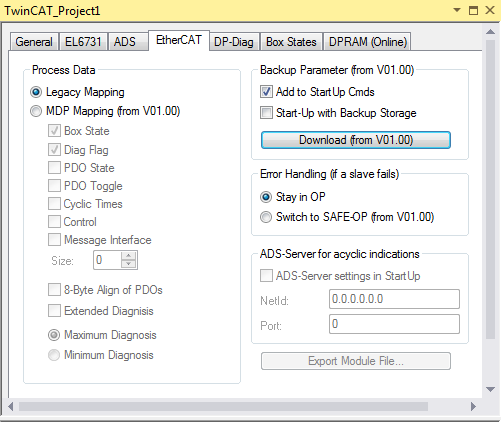EtherCAT

"Legacy Mapping" option
If the "Legacy Mapping" option is selected, the older "Legacy Mapping" implementation is used to map the terminal information of the EL6731 box to the process image.
"MDP Mapping (from V01.00)" option
If the "MDP Mapping" option is selected, the more recent "Modular Device Profile Mapping" implementation is used to map the terminal information of the EL6731 box to the process image. "Modular Device Profile Mapping" offers additional options for setting up the process image for diagnostic information. "MDP Mapping" is supported from firmware version V01.00.
"Box State" check box
If the "Box State" check box is checked, the "DpState" input variable is added to the BK3120 Bus Coupler. It has the type USINT and a size of 1 byte. If the "DpState" variable has the value zero, there is no error. If it assumes a value other than zero, then there is an error. The comment box of the "DpState" variable assigns error descriptions to the values of the "DpState" variables.
"Diag Flag" check box
If the "Diag Flag" check box is checked, the "ExtDiagFlag" input variable is added to the BK3120 Bus Coupler. It has the type BIT and a size of 1 bit. If the "ExtDiagFlag" variable has the value zero, the diagnostic data has not changed. If the value is 1, the diagnostic data has changed. It can be retrieved with an ADS read command.
"PDO State" check box
If the "PDO State" check box is checked, the "PDO State" input variable is added to the BK3120 Bus Coupler. It has the type BIT and a size of 1 bit. If the variable "PDO State" has the value zero, then the slave device is in data exchange. If the value is 1, the slave device is not in data exchange.
"PDO Toggle" check box
If the "PDO Toggle" check box is checked, the "PDO Toggle" input variable is added to the BK3120 Bus Coupler. It has the type BIT and a size of 1 bit. The "PDO Toggle" variable toggles with each successful data exchange.
"Cyclic Times" check box
If the "Cyclic Times" check box is checked, the input variables "Cycle Time", "Cycle Distance Time" and "Output Copy Time" are added to the EL6731 PROFIBUS master device. The variables "Cycle Time", "Cycle Distance Time" and "Output Copy Time" each have the type UINT and have a size of two bytes. The variable "Cycle Time" contains the cycle time of the last cycle, the variable "Cycle Distance Time" indicates the time interval between the last and the penultimate cycle, the variable "Output Copy Time" contains the Output Calc+Copy time of the last cycle. Further information can be found in the comment box of the "Cycle Time" variable, in the comment box of the "Cycle Distance Time" variable and in the comment box of the "Output Copy Time" variable.
"Control" check box
"Message Interface" check box
"Size" NumericUpDown control
"8-Byte Align of PDOs" check box
"Extended Diagnosis" check box
"Maximum Diagnosis" Option
"Minimum Diagnosis" option
"Add to Start Up Cmds" check box
"Start-Up with Backup Storage" check box
"Download (from V01.00)" button
"Stay in OP" option
If the "Stay in OP" option is selected, the EL6731 terminal remains in "Operate" state if a slave device fails.
"Switch to SAFE-OP (from V01.00)" option
This option is supported from firmware version V01.00. If the "Switch to SAFE-OP (from V01.00)" option is selected, the EL6731 terminal switches to "Safe-Op" state if a slave device has failed.
ADS-Server for acyclic indications
An ADS server for acyclic EtherCAT telegrams can be set up here. The acyclic EtherCAT telegrams address the Net ID entered under "NetId" and the port entered under "Port". For example, acyclic EtherCAT telegrams could be sent to a PLC.
"ADS Server settings in Start Up" check box
"NetId" text box
The "NetId" text box contains the Net IDs that addresses the acyclic EtherCAT telegrams.
"Port" text box
The "Port" text box contains the port that the acyclic EtherCAT telegrams address.